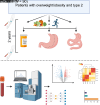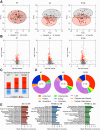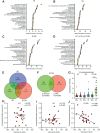Metabolomic Fingerprints of Medical Therapy Versus Bariatric Surgery in Patients With Obesity and Type 2 Diabetes: The STAMPEDE Trial
- PMID: 39311919
- PMCID: PMC11502526
- DOI: 10.2337/dc24-0859
Metabolomic Fingerprints of Medical Therapy Versus Bariatric Surgery in Patients With Obesity and Type 2 Diabetes: The STAMPEDE Trial
Abstract
Objective: Roux-en-Y gastric bypass (RYGB) and sleeve gastrectomy (SG) are effective procedures to treat and manage type 2 diabetes (T2D). However, the underlying metabolic adaptations that mediate improvements in glucose homeostasis remain largely elusive. The purpose of this study was to identify metabolic signatures associated with biochemical resolution of T2D after medical therapy (MT) or bariatric surgery.
Research design and methods: Plasma samples from 90 patients (age 49.9 ± 7.6 years; 57.7% female) randomly assigned to MT (n = 30), RYGB (n = 30), or SG (n = 30) were retrospectively subjected to untargeted metabolomic analysis using ultra performance liquid chromatography with tandem mass spectrometry at baseline and 24 months of treatment. Phenotypic importance was determined by supervised machine learning. Associations between change in glucose homeostasis and circulating metabolites were assessed using a linear mixed effects model.
Results: The circulating metabolome was dramatically remodeled after SG and RYGB, with largely overlapping signatures after MT. Compared with MT, SG and RYGB profoundly enhanced the concentration of metabolites associated with lipid and amino acid signaling, while limiting xenobiotic metabolites, a function of decreased medication use. Random forest analysis revealed 2-hydroxydecanoate as having selective importance to RYGB and as the most distinguishing feature between MT, SG, and RYGB. To this end, change in 2-hydroxydecanoate correlated with reductions in fasting glucose after RYGB but not SG or MT.
Conclusions: We identified a novel metabolomic fingerprint characterizing the longer-term adaptations to MT, RYGB, and SG. Notably, the metabolomic profiles of RYGB and SG procedures were distinct, indicating equivalent weight loss may be achieved by divergent effects on metabolism.
© 2024 by the American Diabetes Association.
Conflict of interest statement
Figures



Similar articles
-
Short-term changes in the serum metabolome after laparoscopic sleeve gastrectomy and Roux-en-Y gastric bypass.Metabolomics. 2021 Aug 5;17(8):71. doi: 10.1007/s11306-021-01826-y. Metabolomics. 2021. PMID: 34355282
-
Comparison of early type 2 diabetes improvement after gastric bypass and sleeve gastrectomy: medication cessation at discharge predicts 1-year outcomes.Surg Obes Relat Dis. 2019 Dec;15(12):2025-2032. doi: 10.1016/j.soard.2019.04.004. Epub 2019 Apr 22. Surg Obes Relat Dis. 2019. PMID: 31711946
-
Early metabolomic, lipid and lipoprotein changes in response to medical and surgical therapeutic approaches to obesity.Metabolism. 2023 Jan;138:155346. doi: 10.1016/j.metabol.2022.155346. Epub 2022 Nov 12. Metabolism. 2023. PMID: 36375643 Clinical Trial.
-
Predictors of glycemic control after sleeve gastrectomy versus Roux-en-Y gastric bypass: A meta-analysis, meta-regression, and systematic review.Surg Obes Relat Dis. 2018 Dec;14(12):1822-1831. doi: 10.1016/j.soard.2018.08.027. Epub 2018 Sep 8. Surg Obes Relat Dis. 2018. PMID: 30385071
-
Bariatric procedure selection in patients with type 2 diabetes: choice between Roux-en-Y gastric bypass or sleeve gastrectomy.Surg Obes Relat Dis. 2020 Feb;16(2):332-339. doi: 10.1016/j.soard.2019.11.013. Epub 2019 Dec 2. Surg Obes Relat Dis. 2020. PMID: 31902579 Review.
Cited by
-
Interventional approaches to combat obesity: Exploring the metabolomic signature of weight loss trials.Metabol Open. 2025 Jun 24;27:100373. doi: 10.1016/j.metop.2025.100373. eCollection 2025 Sep. Metabol Open. 2025. PMID: 40678167 Free PMC article. Review.
-
Metabolomic Alterations in Patients with Obesity and the Impact of Metabolic Bariatric Surgery: Insights for Future Research.Metabolites. 2025 Jun 26;15(7):434. doi: 10.3390/metabo15070434. Metabolites. 2025. PMID: 40710534 Free PMC article. Review.
-
The dual challenge of diabesity: pathophysiology, management, and future directions.Naunyn Schmiedebergs Arch Pharmacol. 2025 May;398(5):4891-4912. doi: 10.1007/s00210-024-03713-4. Epub 2024 Dec 16. Naunyn Schmiedebergs Arch Pharmacol. 2025. PMID: 39680103 Review.
-
Association between triglyceride-glucose index and its combination with obesity indicators and depression: findings from NHANES 2005-2020.Front Psychiatry. 2025 Mar 10;16:1533819. doi: 10.3389/fpsyt.2025.1533819. eCollection 2025. Front Psychiatry. 2025. PMID: 40130189 Free PMC article.
-
Construction of Multi-Modal Transcriptome-Small Molecule Interaction Networks from High-Throughput Measurements to Study Human Complex Traits.bioRxiv [Preprint]. 2025 Jan 23:2025.01.22.634403. doi: 10.1101/2025.01.22.634403. bioRxiv. 2025. PMID: 39896668 Free PMC article. Preprint.
References
-
- Hales CM, Carroll MD, Fryar CD, Ogden CL. Prevalence of obesity and severe obesity among adults: United States, 2017–2018. NCHS Data Brief 2020;360:1–8 - PubMed
-
- Centers for Disease Control and Prevention . Diabetes Report Card 2019. Accessed 11 March 2024. Available from https://stacks.cdc.gov/view/cdc/103877
Publication types
MeSH terms
Grants and funding
LinkOut - more resources
Full Text Sources
Medical
Research Materials

